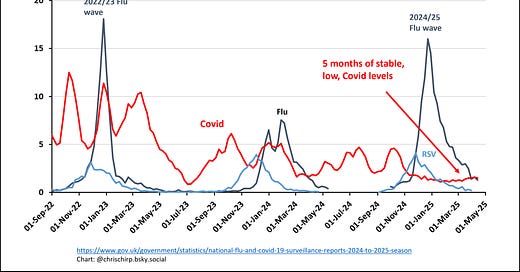Quick update on Covid & state of the NHS in England, April 2025
Slight uptick in recent weeks, but overall Covid levels still low and stable. NHS indicators remain bad.
Covid situation
The latest UKHSA report on respiratory infections came out today, so I thought I’d do a quick update!
Firstly the winter RSV and Flu waves are well and truly over. Secondly, hospitalisations with Covid remain low and stable - now almost six months of stability which we’ve not seen since the pandemic began. That said, hospitalisations have been increasing a bit (about a 15% increase over the 6 weeks), but from a low base.
This is mirrored in the wastewater data from Scotland (remember, wastewater data does not depend on testing!).
UKHSA data on variants does show a recent increase in MC* variants (MC.1.4 and MC.21.1), but data is sparse so don’t read too much into it at the moment.
The NHS spring booster campaign started on 1st April this year - two weeks in and almost a third of over 75s have been vaccinated. Uptake remains disappointingly low in clinically vulnerable groups. Please do get vaccinated if you are eligible!
State of the NHS
Finally, a quick update on NHS indicators. Ambulance times are coming down but are still way above target (which was last met in July 2020), but have at least improved considerably since 2022. Long A&E wait times remain stubbornly high, even though the winter crises have ended. March 2025 was slightly better than February, but there were still over 46,000 people waiting more than 12 hours to be admitted to a bed - compared to just 331 in 2019. Monthly numbers have been over 20,000 since 2021 and there is no sign that the NHS is getting on top of this.
For non-emergency care, waiting lists are coming down very very slowly, but over 6 million people are waiting for treatment. At the current rate of decrease (57,000 net reduction a year), it would be another 30 years before the waiting list was where it was in 2021 (still 4.5 million). Fewer than 60% of people are starting treatment within 18 weeks of referral. The interim target is 65% by 2026, but at current rates of increase, the NHS won’t hit 65% for another decade or so. The Labour government’s plan to reach 92% of patients waiting less than 18 weeks by 2029 seems unachievable without a big change somewhere. Treatment delays directly impact population health and the ability of people to remain in employment or to start new jobs. The NHS remains in crisis and we can only hope that the ongoing reforms will help.










Christina - your updates are my only reliable guides as to how the health of the country is moving. Very much appreciated. Keep it up!
I can only echo the others here in my appreciation of these updates. Thank you.